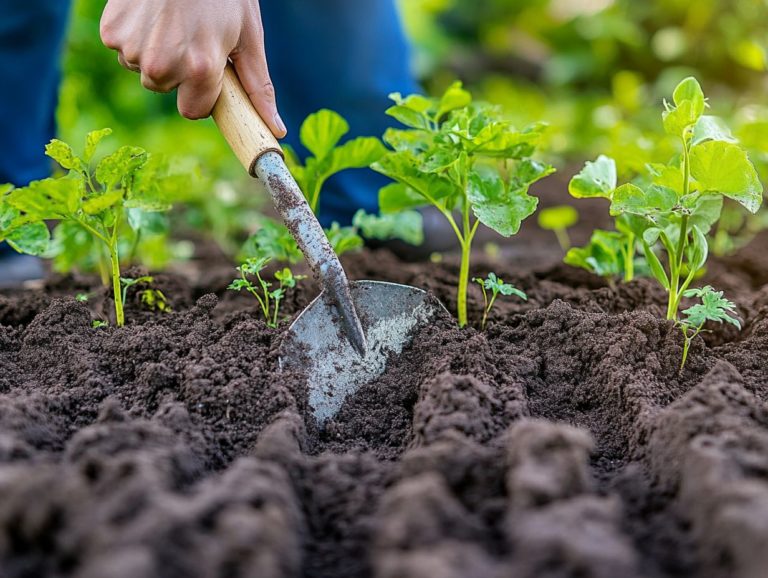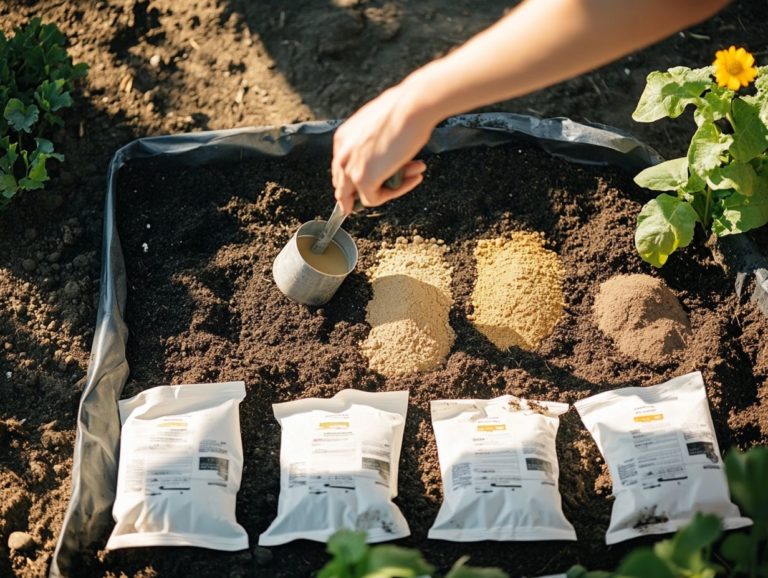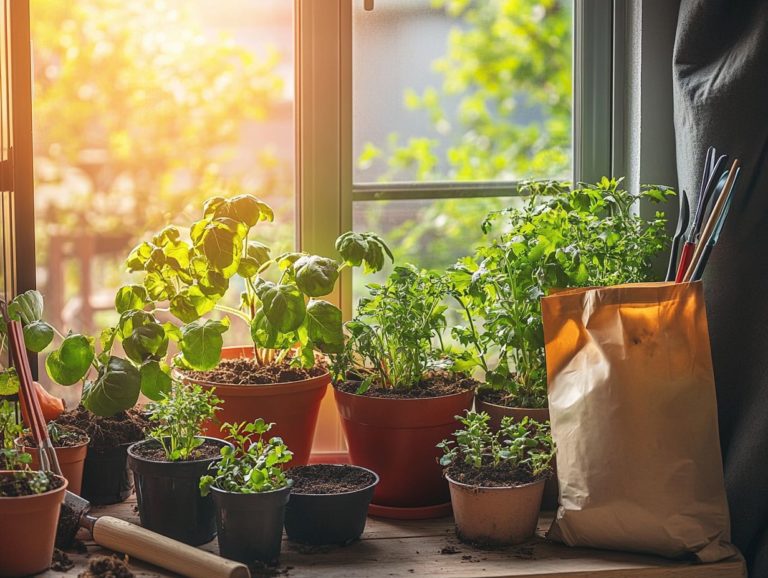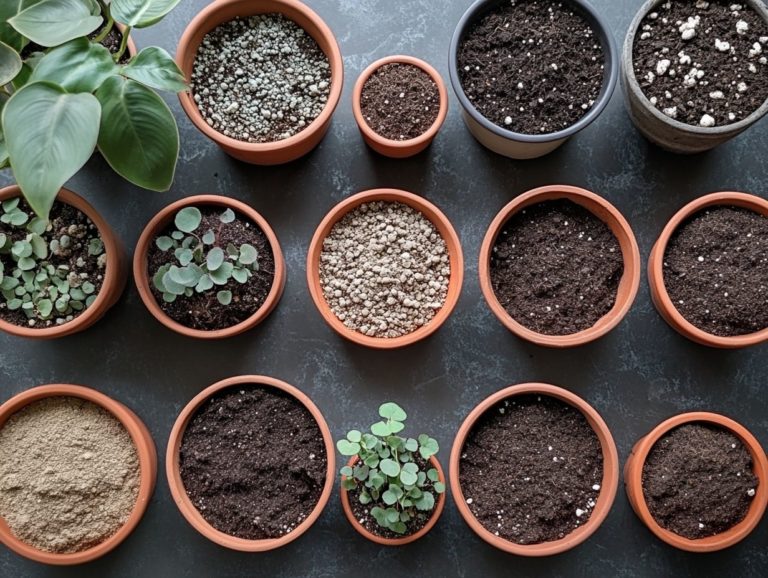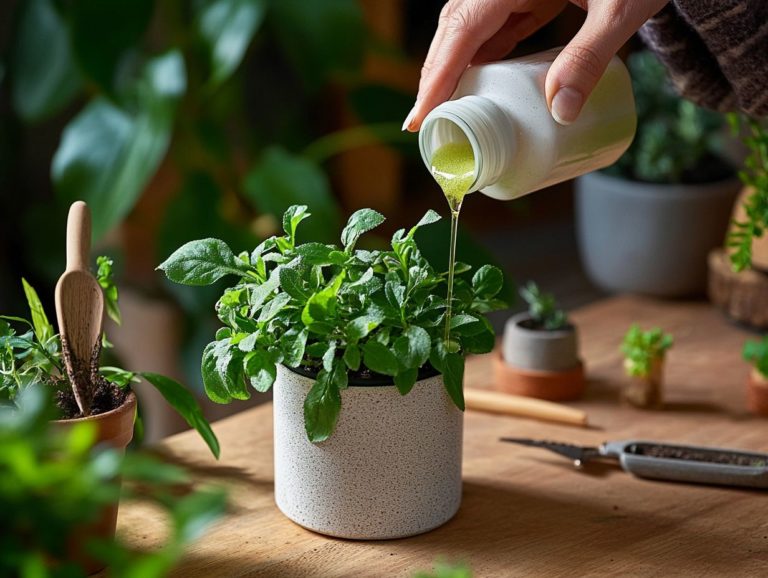Top Indoor Plants for Beginners and Their Soil Needs
Bringing the beauty of nature indoors can elevate your living space, uplift your mood, and enhance the air quality around you. If you’re just starting out with indoor gardening, selecting the right plants might seem a bit daunting.
This guide showcases ten beginner-friendly indoor plants, each with unique traits and soil requirements. From the hardy Snake Plant to the graceful Peace Lily, you’ll uncover the best options tailored for your home.
You will find essential care tips covering everything from watering needs to soil types, ensuring your green companions flourish beautifully.
Contents
- Key Takeaways:
- 1. Snake Plant
- 2. Golden Pothos
- 3. Spider Plant
- 4. Aloe Vera
- 5. Peace Lily
- 6. ZZ Plant
- 7. Philodendron
- 8. Chinese Evergreen
- 9. Rubber Plant
- 10. Dracaena
- What Are the Benefits of Having Indoor Plants?
- What Are the Different Types of Indoor Plants?
- What Are the Key Factors to Consider When Choosing Indoor Plants?
- How Often Should Indoor Plants Be Watered?
- Best Soil Types for Indoor Plants
- How Can One Make Their Own Potting Mix for Indoor Plants?
- What Are the Signs of Overwatering or Underwatering Indoor Plants?
- How Can One Revive an Unhealthy Indoor Plant?
- What Are Some Common Mistakes to Avoid When Caring for Indoor Plants?
- How Can One Incorporate Indoor Plants into Home Decor?
- Frequently Asked Questions
- What are the top indoor plants for beginners?
- What type of soil do these plants need?
- Do these plants require any special soil amendments?
- Can these plants be grown in just water?
- How often should I water these plants?
- Do these plants require any special fertilizers?
Key Takeaways:
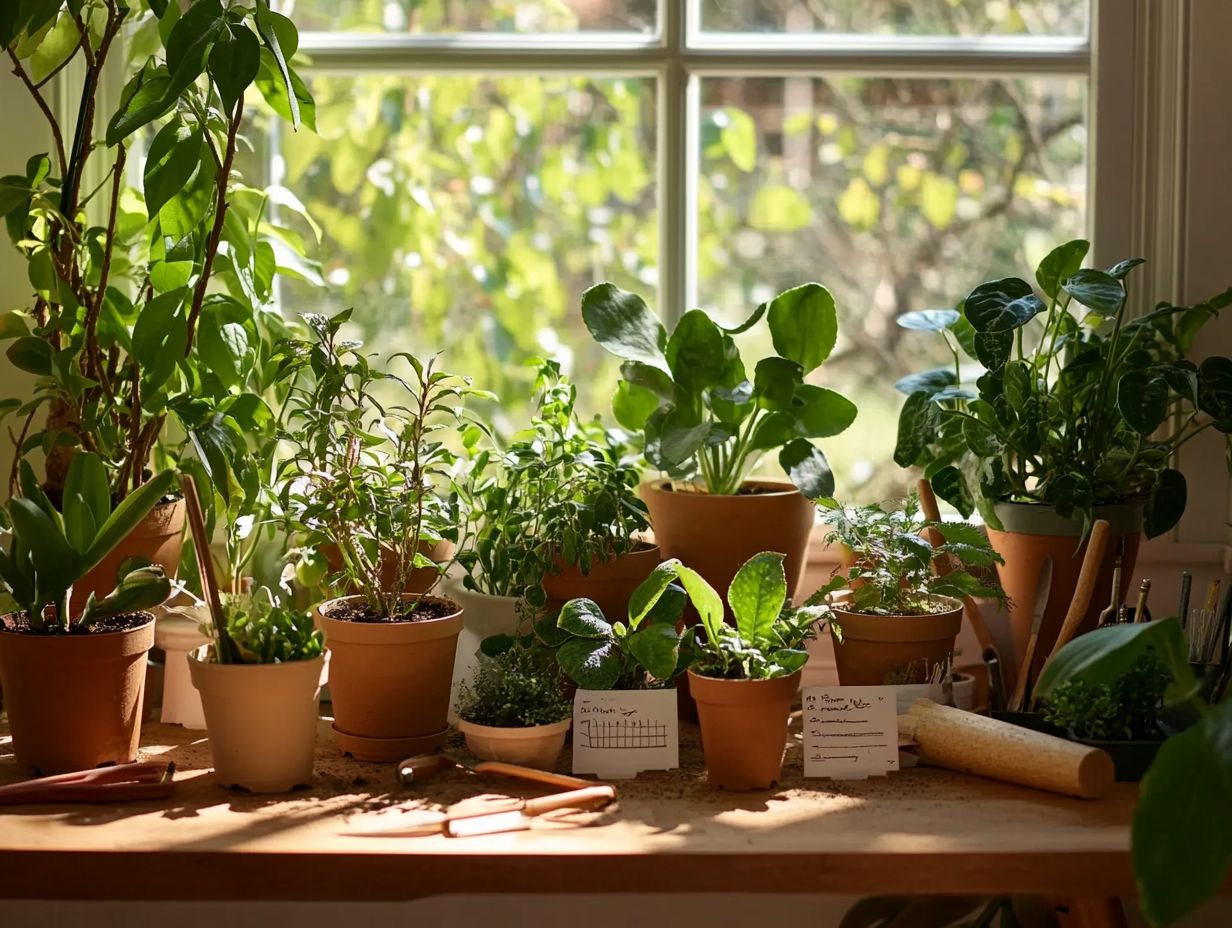
- Choose low-maintenance houseplants like snake plants and Golden Pothos for beginners.
- Indoor plants improve air quality and reduce stress.
- Consider lighting, humidity, and plant size when choosing indoor plants.
1. Snake Plant
The Snake Plant, scientifically known as Dracaena trifasciata, has become a favorite among houseplant enthusiasts, especially those new to plant care. Its low maintenance requirements and ability to thrive in various indoor environments make it a perfect choice.
This hardy plant adds a refreshing touch of green to your space and excels in air purification, filtering toxins from the air and improving indoor air quality.
To cultivate this resilient species successfully, remember that the Snake Plant prefers bright, indirect sunlight but can also adapt to low-light conditions. It s an excellent choice for anyone looking for easy houseplants.
When it comes to watering, embrace the philosophy of “less is more.” Allow the soil to dry out between waterings to prevent root rot, which occurs when roots sit in water for too long. Use a well-draining potting mix that includes sand or perlite to enhance growth.
2. Golden Pothos
Pothos, or Epipremnum aureum, is a must-have for anyone looking to brighten their space! Renowned for its cascading vines and vibrant green leaves, it s perfect for enhancing your home decor.
This remarkable plant isn’t just visually appealing; it’s also incredibly low-maintenance, making it perfect for anyone who might not consider themselves a plant enthusiast. If you’re curious about what indoor plants are best for low maintenance, you’ll find that it requires minimal watering, thriving best when the top inch of soil dries out.
Preferring indirect sunlight, Pothos adapts beautifully to various lighting conditions, making it suitable for both bright and dim spaces. Its ability to thrive in different soil types adds to its charm, allowing beginners to experiment without fear.
With the added bonus of purifying indoor air and promoting a healthier living environment, it s no wonder that this houseplant consistently comes highly recommended for novice gardeners.
3. Spider Plant
The Spider Plant, scientifically known as Chlorophytum comosum, is a delightful indoor companion that embodies the essence of easy houseplants. With its charming arching leaves, this plant adapts effortlessly to various conditions.
Not only does the Spider Plant thrive in diverse lighting situations ranging from bright, indirect light to lower-light environments but it also prefers well-drained soil to prevent root rot. A moderate approach to watering is essential; allowing the top inch of soil to dry out between sessions will support optimal growth.
This resilient plant excels at improving indoor air quality by filtering out pollutants, making it perfect for anyone looking to enhance their living space. With its hardiness and air-purifying capabilities, the Spider Plant stands as a fantastic option for beginners eager to immerse themselves in the world of indoor gardening.
4. Aloe Vera
Aloe Vera, or Aloe barbadensis, is a favorite among houseplants. It s known for its unique look and many benefits, making it a perfect choice for plant lovers.
This sturdy succulent loves bright, indirect sunlight. It thrives in spots where it can soak up light without getting scorched.
Watering is simple: just give it a deep soak every few weeks. Remember, too much water can cause root rot.
With its easy care, Aloe Vera is great for busy lifestyles. It’s also known for soothing skin irritations and providing refreshing gel for home remedies.
5. Peace Lily
The Peace Lily, or Spathiphyllum, is a forgiving indoor plant. It features beautiful white blooms and thrives in low-light, making it ideal for beginners.
Keep it slightly moist, but let it dry out between waterings. Ideally, place it in bright, indirect light for the best growth.
Use well-draining potting mix enriched with organic matter for soil. The Peace Lily is also great for purifying indoor air, making it a top choice for any home.
6. ZZ Plant
The ZZ Plant, scientifically known as Zamioculcas zamiifolia, is perfect for everyone, whether you re a plant lover or just starting out. Its glossy, dark green leaves add beauty and show how resilient it is.
This hardy plant thrives in various lighting conditions and requires little sunlight. It’s a great fit for those dim corners of your home.
Water it only when the soil is dry. This helps prolong its life and prevents root rot.
With its unique traits, the ZZ Plant is an impressive addition to any indoor garden.
7. Philodendron

Philodendrons are a stunning collection of houseplants that offer beauty without heavy care. They re perfect for anyone looking to improve their plant skills.
With varieties available, you can choose philodendrons that match your style and thrive in different conditions. From the classic Heartleaf to the larger-leafed types, each has its own charm.
These plants enjoy bright, indirect light and prefer soil that dries slightly between waterings. They adapt well, making them an excellent choice for homes and offices.
8. Chinese Evergreen
The Chinese Evergreen, or Aglaonema, is a gem among indoor plants, celebrated for its breathtaking foliage and effortless care. If you want to make your space look better with stunning houseplants, this one is a fantastic option.
With a wide array of varieties to choose from, like the vibrant ‘Silver Bay’ and the striking ‘Red Emerald’, you’ll quickly discover the ideal plant that fits your style! These plants thrive in various lighting conditions, especially in lower light environments.
Their adaptability means you’ll only need to water them when the topsoil has dried out. This makes them an excellent choice for beginners or anyone who occasionally forgets to stick to a watering schedule. With just a bit of attention to their basic needs, you can enjoy their captivating colors without the pressure of complicated maintenance. If you’re wondering what soil is best for indoor plants, you’ll find that the right mix can make all the difference.
9. Rubber Plant
The Rubber Plant, or Ficus elastica, is a stunning addition to your indoor space. It enhances your decor while being a low-maintenance choice perfect if you re just starting your journey into taking care of plants.
With its glossy leaves and lush appearance, it flourishes in bright, indirect sunlight, making it suitable for various indoor environments. For those new to indoor gardening, it’s helpful to learn about the best indoor plants for beginners. Remember to keep the soil moderately moist. Allow the top inch to dry out between waterings to avoid the pitfalls of overwatering, which can harm its health.
This plant adapts beautifully to a type of soil that allows excess water to escape easily. Its resilience to diverse light conditions and easy-care nature makes it a beloved choice, effortlessly adding a touch of greenery to any space.
10. Dracaena
Dracaena is a versatile and popular genus of houseplants, known for its striking appearance and low-maintenance care. It’s perfect for anyone looking to elevate their indoor environment, especially if you’re new to taking care of plants.
With over 40 species, each flaunting unique leaf shapes and colors, Dracaena can seamlessly complement any interior design style. These plants thrive in bright, indirect light but are also quite forgiving, happily adapting to lower light conditions.
When watering, let the top couple of inches of soil dry out between waterings. This will help you avoid overwatering, a common pitfall. With just a bit of attention to their needs, these plants can flourish indoors, effortlessly bringing life and beauty to any room.
What Are the Benefits of Having Indoor Plants?
Having indoor plants isn t just about making your space look better; it offers numerous benefits that elevate your living environment, making them a worthwhile investment for any plant enthusiast.
These vibrant additions do more than brighten up your space; they play a vital role in purifying the air, filtering toxins and releasing fresh oxygen. As a result, the atmosphere in your home becomes noticeably cleaner and more invigorating.
Research shows that surrounding yourself with greenery can significantly boost your mental well-being by reducing stress and anxiety. The aesthetic appeal of houseplants can turn any room into a serene sanctuary, inviting you to relax or focus on your tasks.
By embracing these natural elements, you cultivate mindfulness and foster a deeper connection to nature an invaluable asset in today s fast-paced world.
Are you ready to bring some greenery into your life?
What Are the Different Types of Indoor Plants?
Indoor plants present an impressive array of species, each with unique traits and care requirements. Whether you’re a novice seeking low-maintenance options or a seasoned enthusiast looking for something exotic, there’s something for everyone.
Take succulents, for example. Echeveria is a fantastic choice for those who might occasionally neglect watering. These resilient beauties thrive in bright light and boast vibrant colors and captivating shapes that can brighten any space.
Then there are leafy greens like the Snake Plant and Pothos. They infuse your home with a lush, vibrant touch and work wonders by filtering out air impurities. It’s perfect for those who might forget to tend to them regularly.
If you’re drawn to flowering plants, the elegant Peace Lily might just steal your heart. Its stunning blooms add a touch of sophistication and flourish in lower light conditions. This makes it an ideal choice for various indoor environments.
Each category offers remarkable benefits, ensuring you can find the perfect plant friend to enhance your indoor sanctuary.
What Are the Key Factors to Consider When Choosing Indoor Plants?
When selecting indoor plants, consider several key factors, including light requirements, watering needs, and soil type. This ensures your chosen houseplants will thrive in their new environment.
Understanding each plant’s specific needs is crucial for fostering a vibrant indoor garden. If you’re new to gardening, you might wonder what is the best indoor plant for beginners. Some plants flourish in bright, indirect sunlight, while others are content in low-light conditions.
The frequency of watering is equally important. Overwatering can lead to root rot, while underwatering can cause stress and wilting. Familiarizing yourself with these needs allows you to make informed choices, selecting plants that enhance your aesthetic and fit seamlessly into your lifestyle.
This knowledge enables you to cultivate a thriving indoor ecosystem.
How Often Should Indoor Plants Be Watered?

Determining how often to water your indoor plants is essential for their health. Each species has specific watering needs that can vary significantly, impacting their overall growth and vitality.
For instance, low-maintenance plants like the Snake Plant thrive on minimal attention. You should only water them when the soil is completely dry to prevent root rot. On the other hand, more demanding varieties, such as tropical ferns, need consistently moist soil and frequent hydration to truly flourish. To ensure you’re using the right medium, consider learning about what to know about soil for houseplants.
Understanding these distinctions enhances your plant care skills and enriches your indoor garden. Each green companion receives the right level of attention they deserve. Tailor your watering routine based on the unique characteristics and needs of each plant type for optimal results.
Best Soil Types for Indoor Plants
Choosing the right soil type is crucial for your indoor plants, as it directly impacts their growth, drainage, and overall health. This is an essential element of successful plant parenting.
You’ll find that various types of soil and potting mixes can meet the diverse needs of your indoor plants, from cacti to ferns. Succulents thrive in well-draining mixes specifically crafted to prevent excess moisture. Meanwhile, tropical plants flourish in moisture-retaining soils. To choose the right plants for your space, consider the top indoor plants for varied lighting.
Incorporating components like perlite or vermiculite into your potting mix can significantly enhance aeration and water retention. Perlite is a lightweight material that helps improve soil aeration. It s also important to understand the balance of nutrients in the soil. The right mixture feeds your plants, enabling lush foliage and vibrant blooms.
By paying attention to drainage and nutrient content, you ensure that your houseplants not only survive but truly flourish. This reflects the dedicated care you provide.
How Can One Make Their Own Potting Mix for Indoor Plants?
Creating a DIY potting mix for your indoor plants can be incredibly rewarding. You can customize your soil blend to meet the specific needs of your beloved greenery, fostering optimal growth and health.
By carefully selecting the right combination of components, you can enhance both drainage and nutrient levels. This sets the stage for various indoor plants to thrive. For example, incorporating peat moss provides excellent moisture retention, keeping the roots hydrated without risking waterlogging. On the other hand, adding perlite boosts aeration, promoting healthy root development and preventing soil compaction.
Including rich compost in your mix introduces vital nutrients, acting as a natural fertilizer that nourishes your plants over time. With this tailored approach, you can cater to the unique requirements of succulents, ferns, or flowering houseplants, ensuring each type flourishes beautifully in its environment.
What Are the Signs of Overwatering or Underwatering Indoor Plants?
Wondering how to tell if your plants are getting too much or too little water? Recognizing the signs of overwatering and underwatering in your indoor plants is essential for their health. Both extremes can lead to serious issues that impact their growth and vitality.
Overwatering often shows through yellowing leaves, root issues (when roots are too wet and start to decay), and a drooping appearance. This suggests that the roots are drowning rather than thriving. In contrast, underwatered plants may present dry, crispy leaves and wilting a clear sign they’re craving moisture.
To remedy these situations, adjust your watering habits. Check soil moisture levels with your fingers or a moisture meter (a device that measures how wet the soil is). Establishing a consistent watering schedule tailored to each plant s unique needs can make a remarkable difference, ensuring every green friend flourishes in your care.
How Can One Revive an Unhealthy Indoor Plant?
Reviving an ailing indoor plant requires swift action and solid plant care knowledge. This allows you to breathe new life into your beloved houseplants and restore their former glory.
To kick off the revival process, start by assessing the light conditions your plant is experiencing. Inadequate or excessive light can drastically affect its health. Next, review your watering routine. Overwatering can lead to root issues, while underwatering results in dehydration. Don’t forget to examine the soil; it should be well-aerated, neither too compacted nor too dry, as this influences root growth.
Stay vigilant for signs of stress, such as drooping leaves, yellowing, or stunted growth. These cues indicate that your plant may need immediate adjustments in care. By making these observations and necessary tweaks, you significantly increase your chances of rejuvenating your plant.
What Are Some Common Mistakes to Avoid When Caring for Indoor Plants?
Caring for indoor plants can be a rewarding hobby, but as a new plant parent, you may fall into common traps that hinder your plants growth and overall health. Learn from these pitfalls to create a flourishing indoor garden!
Take overwatering, for example. This frequent misstep can lead to root issues, while inadequate lighting might stunt growth or cause those vibrant leaves to yellow. Ignoring specific soil requirements for each type of plant can result in poor drainage or nutrient deficiencies (when plants lack essential nutrients).
By understanding the unique needs of your greenery, such as keeping an eye on moisture levels, providing the right light conditions, and selecting the appropriate soil mix, you can create a thriving indoor oasis. If you’re looking for inspiration, check out the best indoor plants for beginners that infuse your space with joy and vitality.
How Can One Incorporate Indoor Plants into Home Decor?
Incorporating indoor plants into your home decor can truly transform your space. These vibrant plants not only beautify your space but also boost your mood! They enhance not just the aesthetics but the overall atmosphere as well. Moreover, they come with perks like improved air quality and a soothing presence.
When placed thoughtfully, these plants can act as striking focal points or subtle enhancers, effortlessly blending with styles from modern minimalism to rustic charm. For instance, imagine a tall fiddle leaf fig elevating your contemporary living room, while cascading pothos drapes from shelves, adding a whimsical touch to a bohemian-themed nook.
Consider pairing your plants with decorative pots that either match or contrast the room s color palette. This allows each variety to shine without overwhelming the space. Positioning greenery near windows or in bright corners maximizes sunlight exposure, ensuring both vitality and visual impact.
Watch this video for tips on indoor plant care!
Frequently Asked Questions
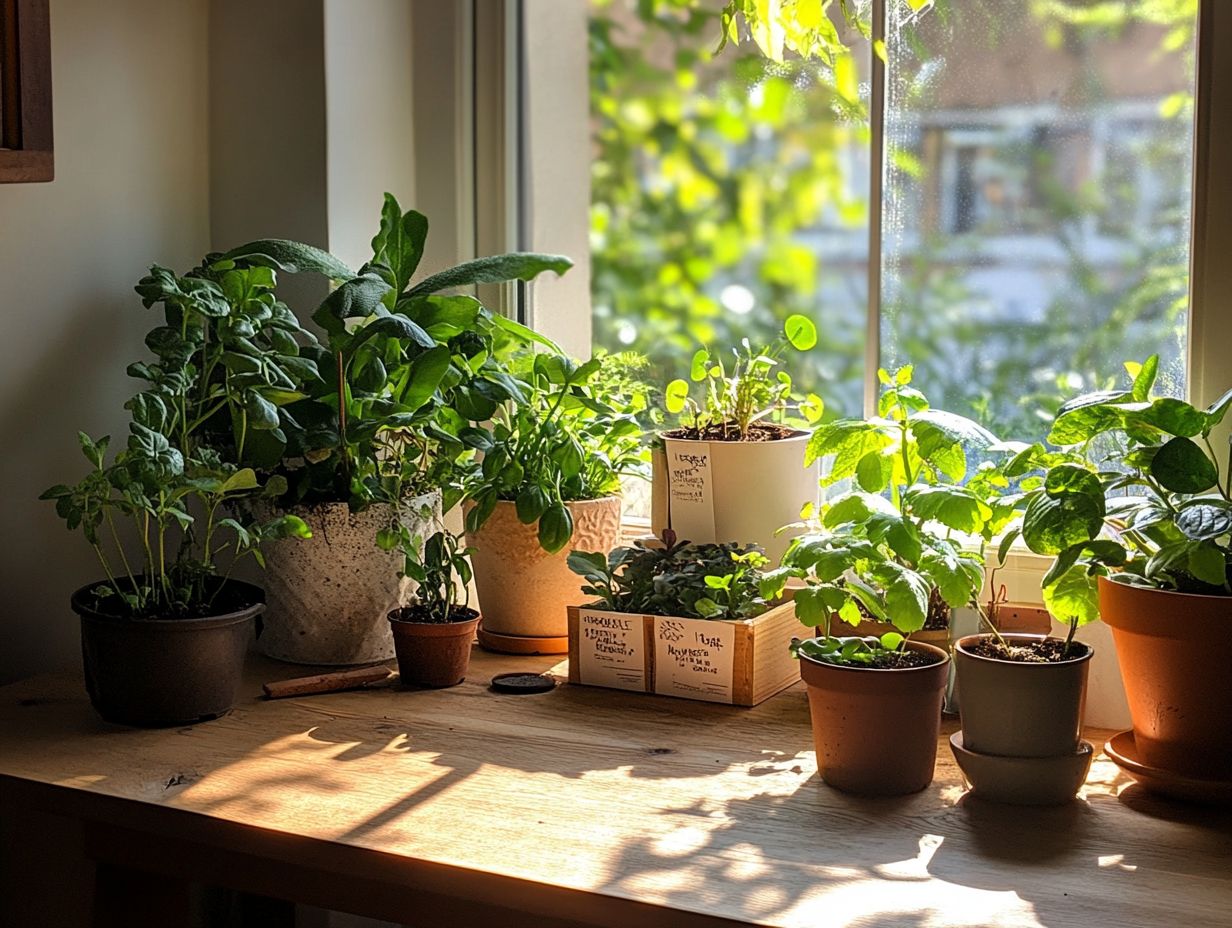
What are the top indoor plants for beginners?
- Spider plants
- Pothos
- Snake plants
- Peace lilies
What type of soil do these plants need?
Most of these plants thrive in well-draining potting soil that is rich in nutrients.
Do these plants require any special soil amendments?
Some plants may benefit from adding coarse materials like perlite (tiny white balls that help with drainage) or vermiculite (light, fluffy granules that hold moisture) to improve drainage.
Can these plants be grown in just water?
Yes! Spider plants and pothos can be grown in just water. Don t wait too long change the water every 1-2 weeks to prevent bacterial growth.
How often should I water these plants?
It’s crucial to let the soil dry out slightly between waterings. Check the moisture level today by sticking your finger into the soil; if it feels dry an inch down, it’s time to water.
Do these plants require any special fertilizers?
These plants can benefit from a balanced indoor plant fertilizer once or twice a month during the growing season. Be sure to follow the instructions on the label carefully.
Ready to green up your home? Start your indoor garden today!

